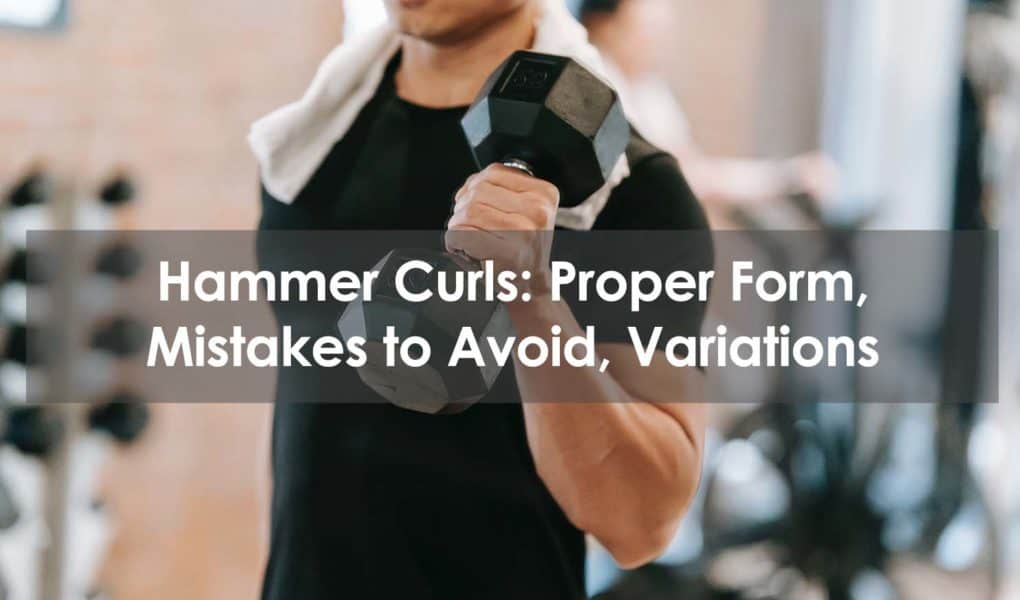The hammer curl is a variation of the standard bicep curl that allows you to, by a simple twist of the wrist, change the target muscles of the curl. The biceps is a double-headed muscle. The hammer curl, in which you hold the dumbbell in the same way you would grab a hammer, places more emphasis on the long head of the biceps brachii muscle and the forearm muscles. In comparison, the standard curl will put more emphasis on the short head of the biceps.
In this article, I’ll lay out the proper form of the hammer curls, point out the common mistakes that can negate the effect of the exercise and provide you with 5 great hammer curl variations.
Hammer Curls Proper Form
Step by step how to:
- Stand with your feet shoulder width apart and a pair of dumbbells held at arm’s length in a neutral grip (palms facing toward your body).
- Maintaining a neutral spine position, hinge from the elbows to bring the dumbbells up to shoulder level.
- Lower and repeat.
Training Tips:
Do not swing your body to get the weight upon the dumbbell hammer curl; keep your hands in the neutral hammer grip throughout the entire movement; squeeze your biceps tightly in the fully contracted position. Move through a full range of movement when you do a dumbbell curl.
Common Mistakes to Avoid
- Using momentum – swinging your body to get the weight up is the biggest mistake used on any version of the curling movement. This is often the result of using a weight that is too heavy for you. The only movement should be through the forearms, not the hips or back. You can reduce the tendency to use momentum by standing with your back against a wall when you perform the exercise.
- Limited range of motion – many people do not come all the way up when they do this exercise, only coming up until their forearms are parallel to the floor. This will not fully work the target muscles. You need to bring the dumbbells all the way up to your shoulders.
- Elbow drift – when you are performing any version of the curl exercise, you should keep your elbows in at your sides. This will prevent the tendency to use momentum while also keeping the emphasis on the target muscles.
Benefits of Hammer Curls
- Builds thickness and muscle mass in the biceps muscle.
- Develops strong biceps muscle.
- Building muscle mass and strength in the key forearm muscles.
- Boosts muscle endurance in the biceps brachii.
- Works the forearm brachioradialis muscle
- Functional strength training
- Improves grip for deadlifts
Hammer Curl Alternatives
The ideal hammer curl alternative will target the same forearm and bicep brachii muscle as the original exercise. These are the long head of the biceps and the brachialis muscle of the forearm. The best alternative arm training exercise is the neutral grip pull up. This exercise is performed on a pull-up bar that has parallel bars so that you can grab them with your palms facing each other. Many power racks have these types of pull up bars fitted to them. If you do not have access to this apparatus, you can do a towel pull-up. To do a towel pull-up, loop rolled up towel over a pull-up bar and grab its end in a neutral grip to perform the pull-up.
The neutral grip pull-up is a great way to increase your time under tension on the bicep muscle by holding the top position for 10-20 seconds.
The neutral grip pull-up is a great alternative to the standard hammer curl for those who are training at home without any barbells.
When performing the neutral grip pull, squeeze your biceps tightly in the top contraction position and grasp the bar tightly to fully activate your forearms.
The next best hammer curl alternative is the reverse barbell curl. This is a forearm centric exercise that allows you to hit the brachialis with a decent amount of weight. Be sure to maintain an upright body position and maintain a neutral spine position.
The third best alternative to the hammer curl with dumbbells is to do the cable version of the exercise. Cables allow you to have tension in the beginning and start position of the exercise, which you do not get with dumbbells. You also have greater incremental progressions on a cable pulley machine weight stack than you do with barbells or dumbbells.
Additional hammer curl alternatives are the kettlebell hammer curl, the incline hammer curl
Hammer Curl Variations
1. Hammer Preacher Curl
Step by step how to
- Grab a pair of dumbbells with a neutral grip position and place yourself on a preacher bench with your arms draped over the bench.
- From a fully extended arm position, curl both arms up to your shoulder level.
- Lower to full extension and repeat.
Training Tips
Use a moderate weight on this exercise as going too heavy places your bicep brachii in a precarious position in the bottom position. You must also lower your biceps under control rather than just dropping your arms back to the start position.
2. Rope Cable Hammer Curls
Step by step how to
- Set the pulleys on a cable machine to its lowest setting. Put a rope attachment on the cable.
- Stand facing the machine, grabbing the rope handle in both hands with a neutral grip position.
- From this starting position, curl the rope handles up to shoulder level.
- Lower and repeat.
Training Tips
Do not use momentum to get the weight up on rope cable hammer curls. Be sure to use a full range of motion and to squeeze your biceps muscle fibres at the top of the movement. Maintain a neutral position through the lower back in order to maintain perfect form. You can perform a version of this arm curl exercise at home by doing the towel curl. To do the towel curl place a rolled-up towel under your foot, grabbing the ends in a neutral grip and curls your leg up to chest level.
3. Zottman Curl
Step by step how to
- Stand with feet hip width apart and a pair of dumbbells held at arm’s length with a palm’s up grip.
- From this initial starting position, curl the weight up to shoulder level then pronate your hands to palm’s down position.
- Lower back to the tart position.
- Supinate your wrists to return to a palm’s up position.
Training Tips
Perform the wrist pronation fluidly as you come to the top of the movement without pausing. Maintain an upright position throughout.
4. Resistance Band Hammer Curl
Step by step how to
- Stand with your feet shoulder width apart and a resistance band looped under your feet. Hold the ends of the band at arm’s length by your sides with a neutral grip (palms facing inward).
- Curl both arms up to shoulder level.
- Lower to full extension and repeat.
Training Tips
Squeeze your biceps tightly in the top position. Do not swing your back or otherwise use momentum to get the band up. If you need to make the exercise harder, twist the band around your wrists to make it shorter.
5. Incline Dumbbell Hammer Curls
Step by step how to
- Lie on an incline bench that is set to a 45 degree angle. Get on the bench with a pair of dumbbells held with a neutral grip. Hang your arms at your sides.
- Curl your right arm to bring the dumbbell up to shoulder level.
- Lower and repeat with the left arm.
Training Tips
Keep your elbows in at your sides. Lower the dumbbells under control and squeeze the bicep muscle in the top position.
The Bottom Line
The hammer curl is a variation of the standard curling movement that places emphasis on the long head of your biceps and your forearms to develop arm strength and bicep and forearm size.
If you don’t have access to dumbbells or are looking for some training variation, you now have 5 excellent hammer curl variations to add to your routine.
When doing your biceps exercise routine, choose two or three exercises and do a total of 10 curl sets, with reps ranging from a high of 30 with lighter weights down to a low of 6 weigh heavy training.
Frequently Asked Questions
Are dumbbells better than using cables for hammer curls?
No, cables are always going to be better than barbells or dumbbells on any curling exercise. That is because they provide resistance in the beginning and end parts of the exercise, which you do not get with free weights. Cables also more perfectly simulate the muscle’s strength curve.
What muscles do hammer curls work?
The hammer curl works the long head of the bicep brachii and the brachialis of the forearms. As well as working the arm muscles, this exercise will also help to strengthen your core and work your abdominal muscles.
Do hammer curls increase grip strength?
Yes, this is an excellent exercise to improve your grip strength. That is because it directly works your forearm muscles and the bicep brachii.







